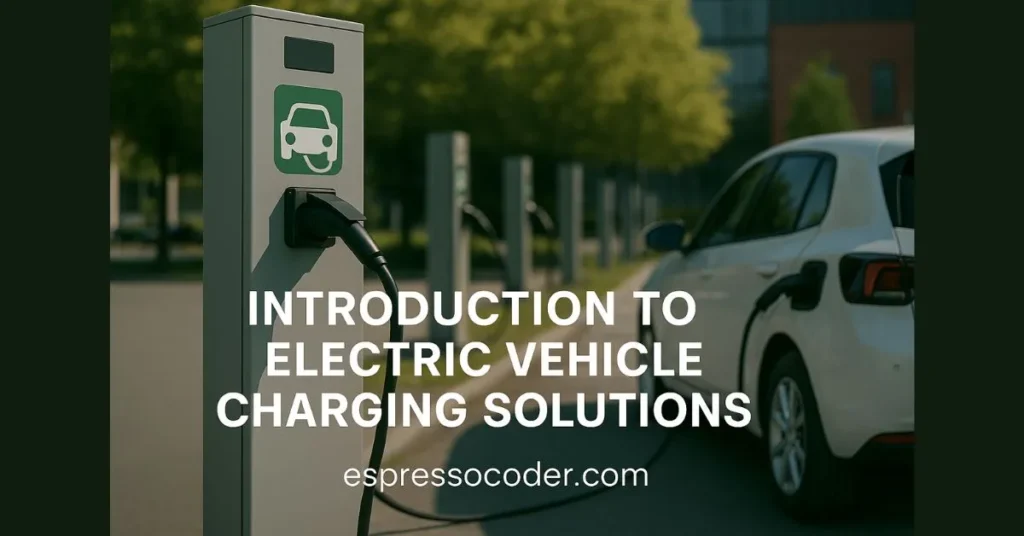Contents
- Introduction to Electric Vehicle Charging Solutions
Introduction to Electric Vehicle Charging Solutions
Electric vehicles (EVs) have emerged as an innovative leap towards more sustainable transportation. As concerns about climate change and environmental sustainability grow, EVs offer a cleaner, more efficient alternative to traditional fuel-powered vehicles. Expanding efficient and accessible charging solutions is vital in supporting this shift. Today, various charging solutions, including EVCS networks, play a pivotal role in meeting the rising demand.
The role of EVCS systems is becoming increasingly integrated into urban planning, offering solutions that fit various lifestyles and usage patterns. From fast-charging hubs to home-based systems, these infrastructures aim to provide seamless support for electric vehicles, bridging gaps that may otherwise hinder widespread adoption. Assessing these solutions becomes vital for a progressive and environmentally responsible future.
The Growth of Electric Vehicles: A Global Perspective
Globally, the shift towards electric vehicles is gathering momentum, marking one of the most transformative trends in the automotive sector. Highlighting a significant change in consumer and governmental mindset, electric vehicle sales continuously surge as nations strive towards reduced emissions. According to the International Energy Agency’s Global EV Outlook, more countries commit to phasing out fossil fuel vehicles and setting ambitious emission reduction targets.
Increased awareness of environmental issues and vehicle technology advancements have contributed significantly to this change. Urban and suburban centers see more electric vehicles rolling out annually, spurred by incentives and a desire for cleaner, cost-effective transportation solutions. As EV technology improves, it provides consumers with broader performance options, offering a compelling case for transitioning away from traditional gasoline cars.
Types of EV Charging Solutions
Home Charging Stations
The most attractive feature for electric vehicle owners is the convenience of home charging. Installing a home charger means an EV can be charged overnight while parked, resulting in a full battery in the morning without any extra effort. This option is the most cost-effective because it allows users to choose charging during off-peak electricity hours, leading to significant savings.
Home charging setups can be customized to suit domestic energy needs, offering flexibility and control over how and when charging occurs. Some home stations integrate innovative technology for energy monitoring and optimized charging times, reducing household energy consumption and cost.
Public Charging Networks
The development of public charging networks is essential to making EVs practical for people who cannot charge at home. These networks ensure drivers have the necessary infrastructure to recharge their vehicles during commutes, travels, and more. Such stations are often found in busy urban areas, providing convenient options for those living in apartment buildings or high-density housing where personal charging stations might not be feasible.
These networks provide the infrastructure for longer trips and primary commutes and incentivize more individuals to consider transitioning to electric vehicles. Ensuring that the charging time fits seamlessly into everyday activities like shopping or dining further reinforces the accessibility of electric transportation.
Fast Charging Options
Fast charging stations represent a crucial step in advancing the appeal of electric vehicles. These stations reduce downtime significantly by providing rapid energy top-ups, allowing drivers to recharge their cars in minutes instead of hours. Fast chargers make it feasible for EV owners to consider long-distance travel without the overwhelming concern of running out of power.
The strategic placement of such stations along highways and busy routes ensures that EV users can continually experience the flexibility previously enjoyed by traditional vehicle users. Fast charging becomes an indispensable component in the landscape of EV charging solutions by encouraging wide-scale adoption and eliminating range anxiety.
The Environmental Impact of EV Charging Infrastructure
While electric vehicles offer considerable emissions savings compared to traditional cars, the environmental impact of the supporting charging infrastructure is an important consideration. The source of electricity is a determining factor, with the potential for carbon-heavy or carbon-neutral implications depending on whether energy is sourced from renewables like wind and solar versus fossil fuels.
The continued integration of clean energy in developing these charging stations can magnify electric vehicles’ positive environmental impact. By decreasing the carbon footprint associated with electricity generation, sustainable charging infrastructure supports a more comprehensive approach to environmental responsibility.
Challenges in Expanding EV Charging Networks
The expansion of EV charging networks entails several challenges that must be addressed to support their widespread adoption. Cost remains a primary barrier to implementing extensive infrastructure, and increased investment from the governmental and private sectors is crucial.
Other challenges include spatial limitations in urban environments and keeping pace with rapidly evolving technology. Developing smart stations that can adapt as technology and user demand change must form a core strategy. Creative design and insightful policy-making can address these challenges by enabling more flexible and widespread installations of EV charging solutions.
Government Initiatives and Policies
Governments worldwide are pivotal in supporting the proliferation of electric vehicle charging infrastructure. Strategic initiatives like financial subsidies and supportive regulations empower public and private entities to implement and expand EVCS systems. Policies that foster conducive environments for infrastructure growth reflect governments’ commitment to reducing national carbon footprints.
These incentives encourage rapidly growing networks, from grants and tax breaks to partnerships with private enterprises. Such efforts expedite the transition to electric vehicles and promote innovation and competition within the industry, leading to advancements in charging technology and increased accessibility.
The Future of EV Charging Technology
The future of EV charging solutions is exciting and promising, with advancements paving the way for more intuitive and efficient charging. Emerging concepts like wireless charging and battery-swap stations could revolutionize the EV landscape, eliminating the need for traditional plug-in methods and adding unprecedented convenience.
Smart grids and integrated digital platforms promise further innovation in monitoring and managing energy consumption, optimizing power distribution, and reducing consumer costs. Such technologies are anticipated to smooth the transition for those hesitant about switching from fossil fuel vehicles, ultimately accelerating the adoption and popularity of electric mobility.
Conclusion: Moving Towards a Greener Tomorrow
The rise in electric vehicle charging solutions signifies a pivotal movement toward sustainability in transportation. As infrastructure continues to evolve and adapt to meet global needs, the prospect of a future dominated by electric vehicles becomes all the more attainable. The comprehensive integration of these solutions encourages a seamless transition, allowing every driver to contribute to a sustainable, cleaner environment, thereby paving the path towards a greener tomorrow.

